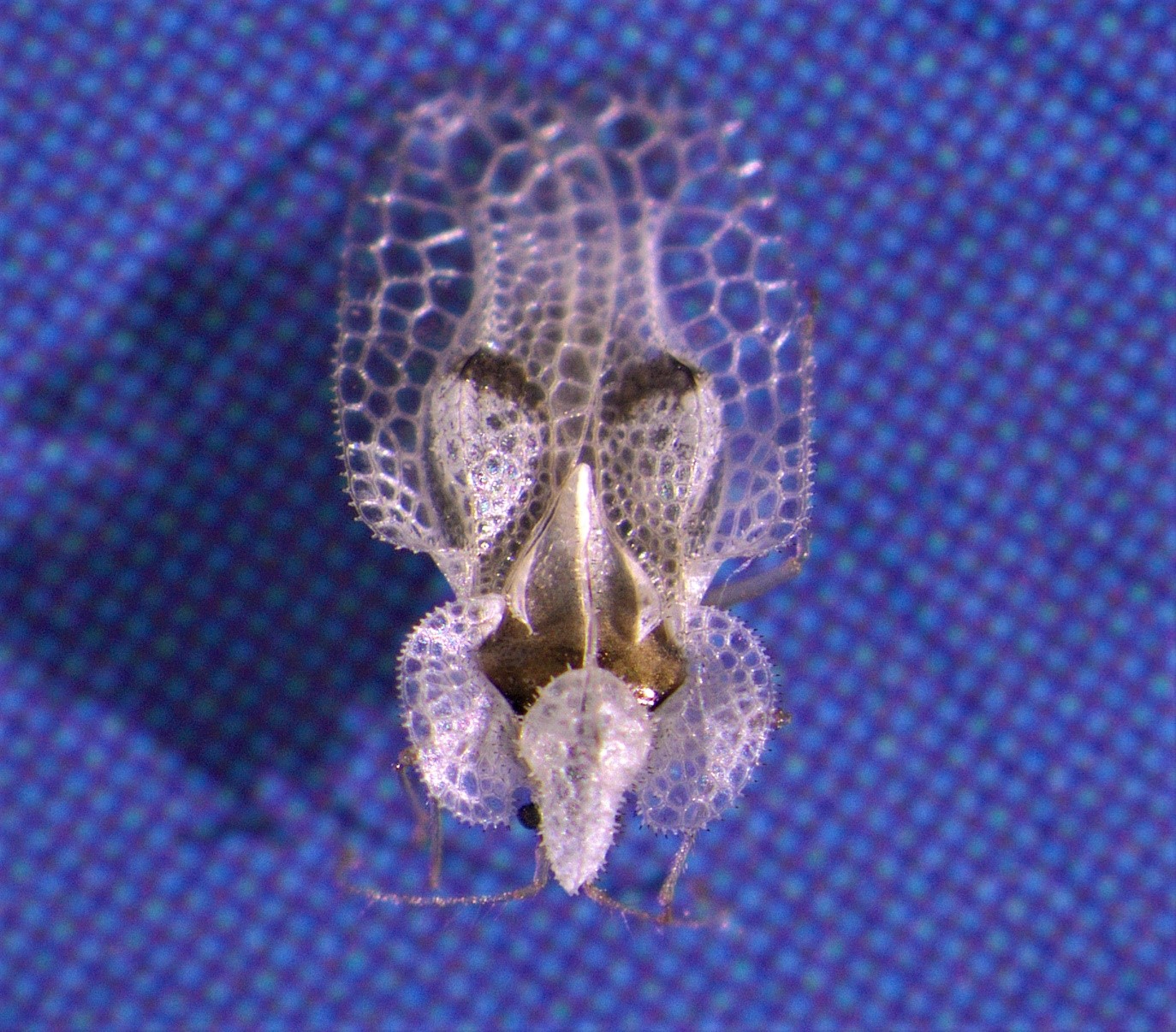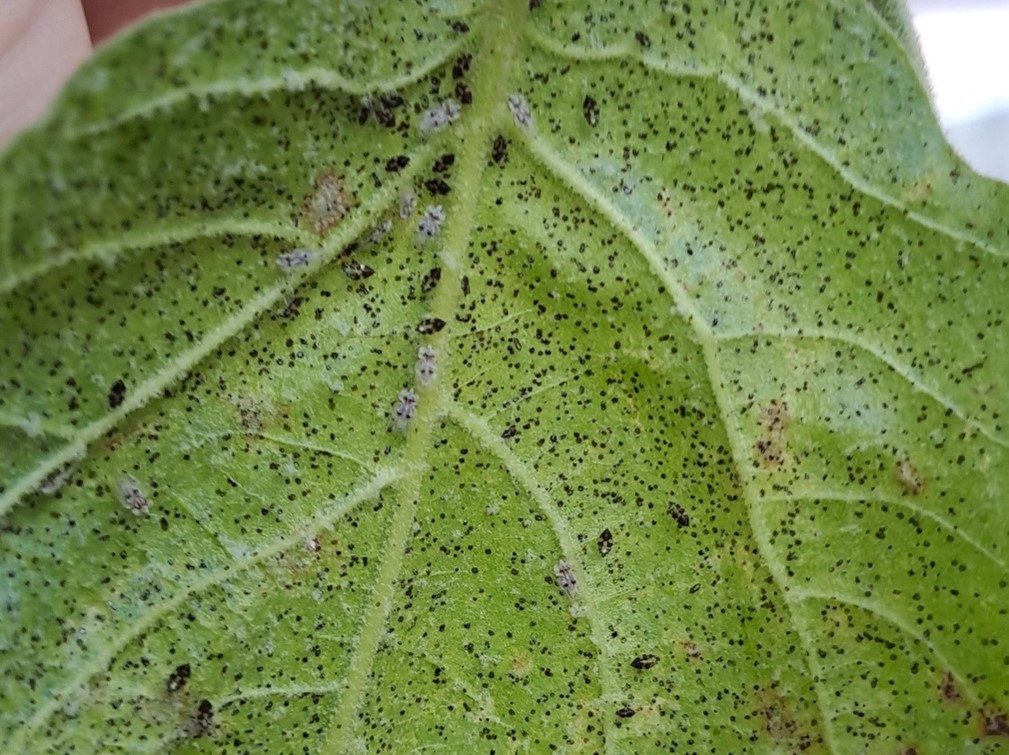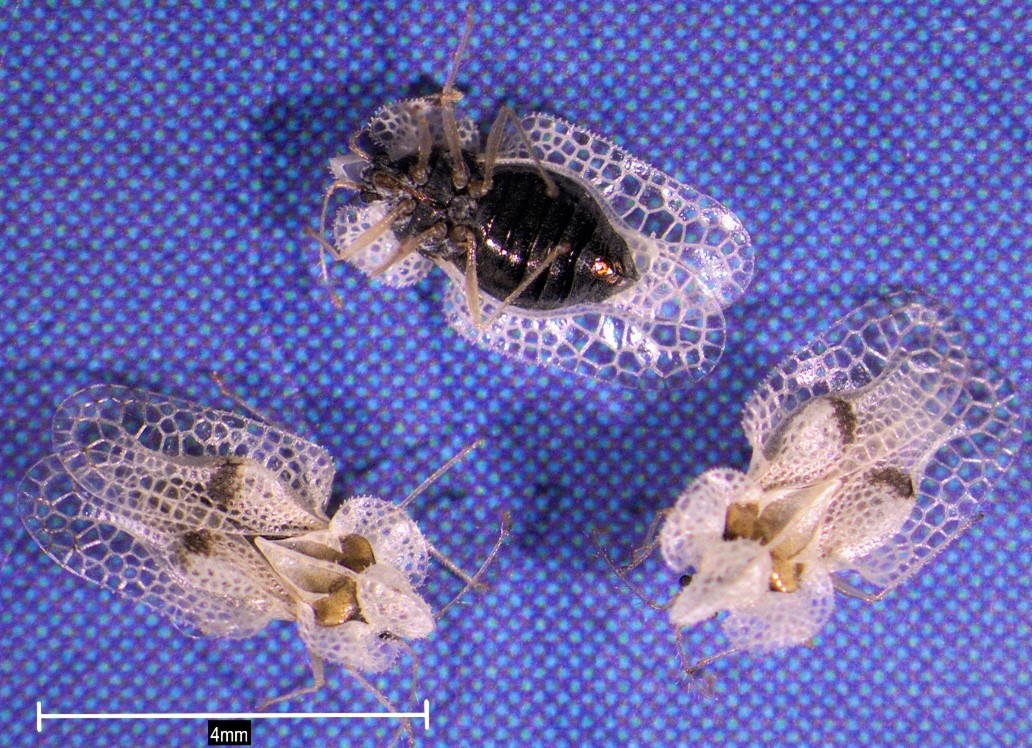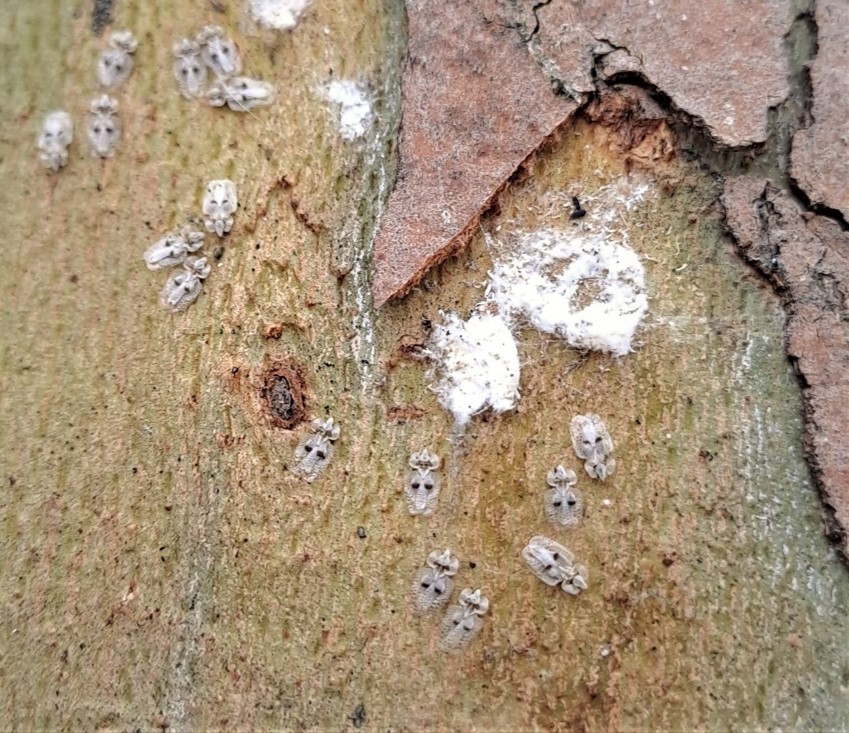Plane lace bug (Corythucha ciliata)
Present in the UK (Distribution unknown although likely to be limited)
We welcome records of this pest – see ‘Report a sighting’ below
Scientific name – Corythucha ciliata (C. ciliata)

Plane lace bug (PLB), also commonly known as the Platanus lace bug or sycamore* lace bug, is an insect pest of plane (trees in the Platanus genus). It is native to North America.
Plane lace bug is native to North America; however, it has been introduced to and since spread through many different countries around the world. It was first discovered in Europe in 1964 in Padova, Italy, and by 1986 it had spread to at least nine other countries, including France. It has since been introduced to other countries, including Korea, China, Australia, Japan and Turkey.
Plane lace bug was first found in the UK in 2006, when a small population of the species was discovered at a plant nursery in Bedfordshire, likely associated with imported plants. Spraying with pesticide was recommended and no evidence of persistence of the pest was found over subsequent years, so the pest was presumed to be no longer present in this country.
Plane lace bug has more recently been identified on plane trees in central London, in summer 2024, on a number of street and park trees. Plane lace bug is spread locally by adults flying or being blown to new host trees, and it can also be transported through hitchhiking on vehicles, clothing or bags.
The primary hosts of the plane lace bug include the London plane (Platanus x hispanica), oriental plane (P. orientalis) and American sycamore (P. occidentalis). Other Platanus species including P. racemosa have been reported for this insect pest; however, the three main Platanus species listed above are considered to be most at risk from this pest in the UK.
Several other host plant genera are listed in the literature, including Broussonetia papyrifera, Carya ovata, Chamaedaphne spp., Fraxinus spp. and Quercus laurifolia; but these are not considered to be its main hosts, and it is not clear if the insect can successfully reproduce on them.
*Plane lace bug, despite being known as the sycamore lace bug across America, does not attack what we know as sycamore trees (Acer pseudoplatanus). The confusion arises because trees in the genus Platanus are known as sycamores in North America, whereas in the UK, sycamore refers to Acer pseudoplatanus, the sycamore maple, and trees in the genus Platanus are instead known as planes.
On the continent, plane lace bugs can produce two or three generations a year. Beginning in the spring, the adult females lay eggs on the undersides of leaves. The nymphs hatch from the eggs within days and go through five stages, known as instars, before reaching adulthood. A complete life cycle takes approximately 30 to 40 days, depending on the ambient temperature.
Plane lace bugs are more prevalent in late summer and autumn, and adults and nymphs will be feeding at the same time in late summer. Some of each year’s final generation of adults overwinter under loose bark, leaf litter and in bark crevices, and tolerate extreme temperatures as low as -30ºC. At the other extreme, plane lace bug can tolerate high summer temperatures of up to 40ºC.
The wings of the adults are very delicate, and they rarely fly very far; however, when supported by the wind, they can be blown over many kilometres.
Human activity is thought to be the main cause of the insect’s spread over long distances. The pest can also be moved on other types of plant material, such as plants for planting, and by hitchhiking, i.e., by attaching to vehicles travelling long distances.
There is little that can be done to stop the movement of the pest.
Thankfully, in most years, the only noticeable effect of plane lace bug will be bronzed foliage and early leaf drop. After many consecutive years of plane lace bug feeding at high densities, trees may become weakened and more vulnerable to opportunistic fungi and disease. If this repeated damage occurs in combination with other environmental influences like drought, this may kill the tree. This could lead to economic impacts of replacement, and localised environmental impacts.
When occurring in very high densities, there have been reports of plane lace bug falling from infested trees and biting people. This can cause an itchy reaction in some, called dermatosis. Biting has been recorded in Paris, France, Piedmont, Italy, and Bucharest, Romania which all have broadly similar climates to the UK, but there are a very limited number of any recorded cases of this.
Control of the plane lace bug is not feasible – use of insecticides on mature plane trees would be impractical due to the costs and the difficulties of applying pesticides to fully grown trees. Plane lace bug adults take shelter under the flakes of bark found on plane trees, protecting them from control attempts. Such control measures would also have considerable non-target impacts which the largely aesthetic damage caused by plane lace bug would not justify.
To prevent the spread of plane lace bug it is important that, where possible, no leaf litter, bark-covered wood or foliage from infected trees is removed from a site because there may be plane lace bug adults, juveniles and eggs present on the material. Where practicable, leaves can be composted on-site, or disposed of in a bio secure manner, such as incineration.
Given the low risk to human health posed by this pest when insect densities are very high, during heavy infestations, sitting directly below plane trees could be discouraged where deemed necessary through the installation of information signs highlighting the presence of the pest in the local area.
On young plants, such as those in nursery environments, spraying using approved insecticides can be an effective control method for PLB.
The plane lace bug feeds on the foliage of plane trees, causing chlorosis (loss of normal colour) to occur on the upper surface of the leaves. Lace bugs use their piercing– sucking mouthparts to rupture plant cells to feed on the nutritious sap within.

Picture: chlorosis on upper surface of plane leaf caused by feeding damage.
The first sign of feeding damage is a stippling of small, yellow spots on the upper leaf surface, often concentrating around the leaf veins. As the lace bug populations increase, the chlorotic spots coalesce to produce large, yellow- and bronze-coloured areas on the upper leaf surface. Heavy infestations can also cause premature leaf drop.

Picture: underside of infested leaf – nymphs, frass spots and adults visible
Adults and juvenile (nymphal) stages, as well as eggs, may all be present simultaneously on the underside of affected leaves. The adults are recognisable because of their delicate milk-white lacy wings with variable brown markings, and the nymphs because they are flattened, wingless, black, spiny and oval. The adults and nymphs reach a maximum length of 4 and 2 mm respectively. The eggs are 0.5 mm long, elliptical, and brown with a lighter coloured lid, and tend to be found in clusters along main leaf veins on the underside of leaves

Picture: adult plane lace bugs
Lace bugs deposit droplets of liquid frass onto the undersides of leaves as they feed. These dry out into hard, black spots and are characteristic of lace bug infestations. These black frass spots will be visible on fallen leaves and can be scratched off of the leaf surface using a thumbnail, unlike similar-looking imperfections which form a natural part of the leaf. Cast nymphal skins will also be visible on the underside of leaves.

Picture: group of adult plane lace bugs under peeled bark
One of the easiest ways of detecting the presence of plane lace bug is to peel off the bark platelets during the autumn, winter or early spring, to find the overwintering adults sheltering underneath. Removing a few bark platelets like this is not harmful to the tree and simply speeds up the natural process of bark exfoliation (shedding) that these species naturally undergo.
Although there are several native lace bugs in the UK, none of them breed on plane trees, so if you come across a lace bug on plane it is very likely to be a plane lace bug. The closely related Oak lace bug (Corythucha arcuata) – Forest Research, not yet known to be in the UK, is similar in appearance and feeds on a range of broadleaves trees.
Various other insects cause foliar symptoms on plane, in particular leafhoppers, which feed in a similar manner to plane lace bugs and therefore cause similar damage. However, a plane lace bug infestation is distinguishable from that of the leafhopper by the presence of lace bug adults and juveniles on the underside of the leaves, and the distinctive black frass spots.
Other insects such as leaf miners also affect plane leaves; however, the relatively large mines which they produce bear no resemblance to the damage caused by the plane lace bug.
Observatree’s identification field guide, this government pest alert and this DEFRA plant pest fact sheet have more information and images to help identify the insect and its symptoms. Please note that some contact, reporting and website details given in the first two documents have been superseded by those given on this page, so where they are different, please use those given on this page.
We encourage tree and ground-care professionals, plane tree owners and managers, and the public, to be vigilant for signs of plane lace bug and to report suspected sightings. This helps us to monitor the spread and presence of PLB.
Please note that TreeAlert and TreeCheck both require photographs to be uploaded. These should be clear, well-lit, close-up pictures of symptoms.
Place lace bug is not regulated in the UK or at a European Union level, because it is already present in several Member States.
Imported plane trees and wood of plane are regulated due to the threat from canker stain of plane (Ceratocystis platani) and other pests including Asian longhorn beetle (Anoplophora glabripennis). More information on canker stain of plane is available here: Canker stain of plane (Ceratocystis platani) – Forest Research.
Professional operators who are managing operations with plane trees and who commission the movement of plane material must issue a plant passport when moving plane material to a processing site.
Corythucha ciliata is not a regulated pest which means there is no obligation to take statutory action. Further information can be found here: UK Plant Health Risk Register.